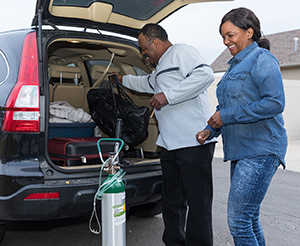Traveling with Oxygen
Traveling with Oxygen
Your healthcare provider has prescribed an oxygen device for you. Using an oxygen device doesn’t mean you can’t travel. It’s OK to travel with oxygen. You just need to plan ahead.
Call your healthcare provider to get copies of your oxygen prescription and any other paperwork you’ll need. You may need to arrange for oxygen to be delivered, depending on where you are going and how you are getting there. Or you may be able to go to a supplier at your destination. Many oxygen suppliers have offices across the country and in other countries. Your healthcare provider's office or medical equipment company can help with these plans.
Before you travel, call the carrier to find out the needs for traveling with oxygen. Give yourself plenty of time to make plans.
Types of portable oxygen devices
Talk with your healthcare provider about one of these choices for travel:
Compressed oxygen tank. This is oxygen gas stored in a tank under pressure. Small tanks can be carried.
Liquid oxygen unit. This contains oxygen gas cooled to a very low temperature. Most tanks come with a portable unit that you can carry or pull on a cart. Some of these weigh only a few pounds. Liquid oxygen units are easy to carry around.
Portable oxygen concentrator (POC). This device doesn’t contain oxygen. It takes in the air around you to concentrate oxygen and give you more of it. It uses electricity from a battery or by plugging into an outlet.
Traveling by car
Place the oxygen unit upright. Put it on the floor or on the seat beside you. Secure the unit with a seat belt.
Don’t smoke or let anyone else smoke in the car.
Keep the windows open at least crack so air can circulate.
Store extra oxygen units upright in the trunk or on the floor of the car.
Don’t leave oxygen units in a hot car.
Traveling by cruise ship
When you book your cruise, tell the cruise company that you’ll be traveling with oxygen. Most cruise lines require a 4- to 6-week notice to travel with oxygen.
Ask your healthcare provider to give the cruise company a letter that includes a brief health history and your oxygen prescription.
Work with your oxygen supplier to have oxygen units sent to the cruise ship before you depart. Ask the supplier to tell you how many tanks you’ll need at ports of call. The supplier may be able to arrange those for you.
Traveling by plane
Start making your plans at least a week in advance. Many airlines require that you tell them a few days to a week before you fly with oxygen.
Before booking a ticket, find out the airline’s policy for using oxygen in flight. You can’t take compressed gas or liquid oxygen on planes. But you may be able to use an FAA-approved POC. Or the airline may give you in-flight oxygen for a fee, but not allow personal oxygen devices. You’ll also be limited to where you can sit on the plane. Check the airline’s website or call the customer service number to find out its policy.
If the airline allows a POC, make sure your POC is approved by the FAA. Check the agency’s list of approved devices at www.faa.gov.
When you make your reservation, tell the airline that you’ll need oxygen during the flight. You may need to send a copy of your oxygen prescription and a letter from your healthcare provider saying you are approved for air travel and need in-flight oxygen. You may also need to fill out the airline’s medical form. Bring enough copies of this information with you to give to staff members for all flights as needed.
If you will be using the airline’s oxygen system, bring your own nasal prongs or adaptor. Some airlines only supply masks.
If you will be using your POC, make sure to bring extra batteries. Most airlines don’t allow a POC to be plugged in on the plane.
If you will be using the airline’s oxygen system, keep in mind that it’s only on the plane. You will need to use your POC in the airports before and after the flight.
Arrange for extra oxygen supplies to be at your destination when you arrive. Also arrange for oxygen for any layovers during your flight.
Traveling by bus or train
Call the local bus or train office at least 3 days before you depart. Tell them that you’re traveling with oxygen. Ask about their policies. Most bus or train companies allow personal oxygen devices onboard.
Ask for seating in a nonsmoking area.
Bring extra oxygen units as baggage if allowed.
Carry your oxygen prescription with you.
Traveling outside of the U.S.
Policies for traveling with oxygen vary by country. For example, some international airlines don’t have oxygen or allow devices. Work with a travel agent to help make plans for any travel abroad. Make sure to plan far ahead and have all of your medical paperwork ready.
When to get help
While traveling, ask for medical help right away if you have any of the following:
Pale skin or a blue color to your skin
Heavier or faster breathing than usual
Trouble breathing, even with your oxygen in place
Chest pain
Updated:
February 27, 2018
Sources:
Airlines and Their Criteria on POC Usage. Airline Oxygen Council of America., Patient Information: Supplemental oxygen on commercial Airlines (2012). UpToDate., Why Do I Need Oxygen Therapy? American Thoracic Society.
Reviewed By:
Cunningham, Louise, RN,Images Reviewed by Staywell medical art team.,Pierce-Smith, Daphne, RN, MSN, CCRC,Stock, Christopher J., PharmD, BCPP
